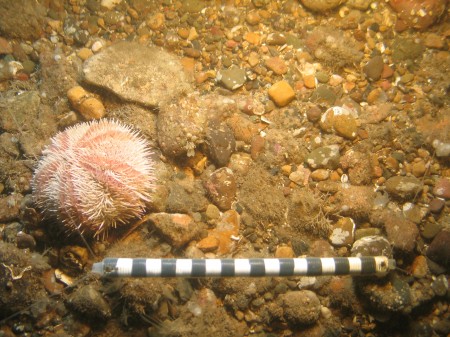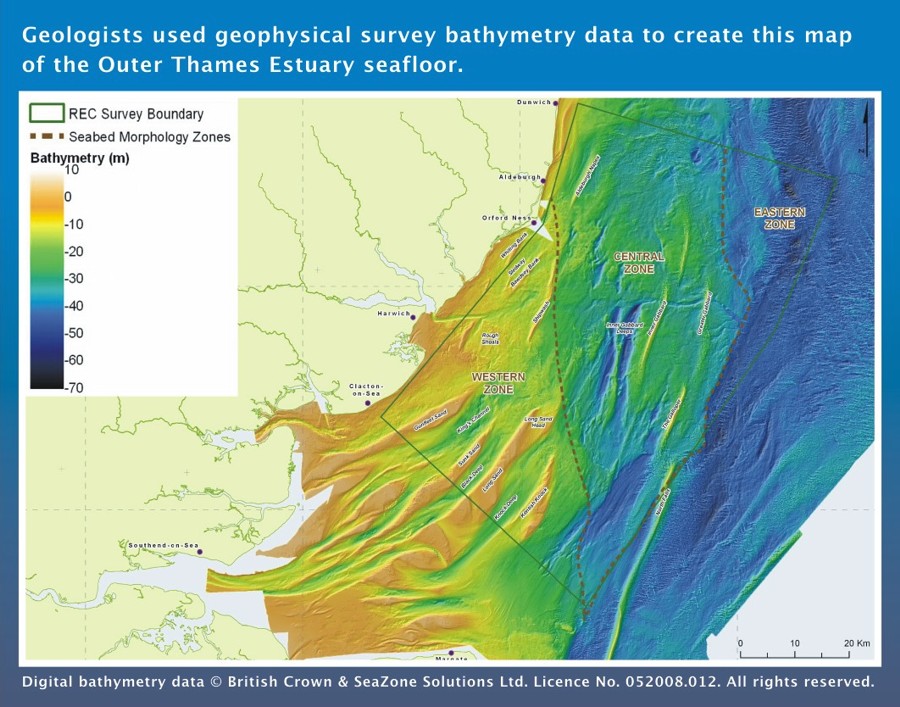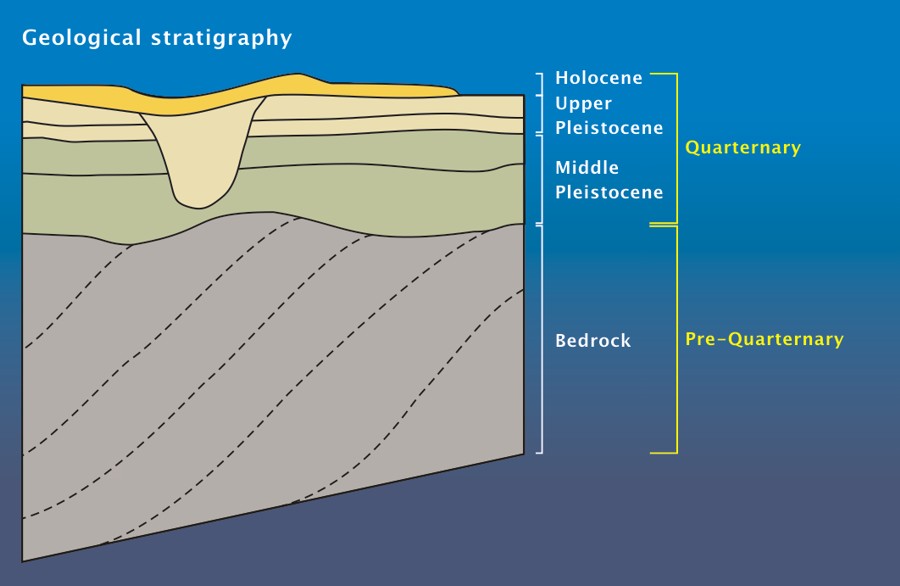Geologists studied the formation and structure of the Outer Thames Estuary seafloor – how it was shaped, what the sediment cover on the seafloor is made of and what rock formations lie beneath the seafloor sediments. This information is vital to the RECs, creating maps of the seafloor for other scientists to use.
Geologists use two main methods to study the seafloor and underlying sediments and rocks. Geophysical survey techniques use sound waves to map the seafloor morphology, the thickness of seafloor sediments and the rocks underlying these sediments. They also take samples of the seafloor sediments and underlying rocks using grabs and vibrocores to ‘ground truth’ the geophysical surveys.
The geological maps form an essential foundation for the Outer Thames Estuary REC archaeological and ecological research and interpretations. They help identify where humans might have lived when sea levels were lower, exposing the seafloor, and on what type of sediment certain groups of animals prefer to live today.
Outer Thames Estuary Geology REC results
This section provides a summary of the Outer Thames Estuary REC results for the geological research.
Click on links below to find out about each topic, or scroll down to read the entire text.
- What does the seafloor look like?
- What is the seafloor made of?
- Geological timechart
- Underneath the seafloor
- How is the seafloor made?
You can find out more about the scientific research techniques mentioned in the text by visiting our “How we study seafloor” webpages.
You can find out more about the role of geology in other areas of the REC research by visiting the Outer Thames Estuary Ecology, Archaeology and Sustainability webpages.
What does the seafloor look like?
An important task for the Outer Thames geologists is to understand the morphology of the seafloor. This involved creating a 3-Dimensional map of what the seafloor looks like.
Geologists added the new geophysical survey data to existing datasets to create a map of the modern seafloor. The Outer Thames Estuary REC maps highlighted major features on the seafloor. Geologists studied two deep, parallel channels called the Inner Gabbard Deeps. It is probable that they formed over 10,000 years ago during the last Ice Age, carved into the seafloor by fast-flowing rivers underneath the ice sheet.
The map shows that the Outer Thames Estuary REC study area consists of three main morphological zones, which each have distinctive features.
Western Zone: a large sandbank running parallel to the coast dominates this area.
Central Zone: mainly bedrock seafloor with thin layers of gravel. It has areas of bedforms and isolated sandbanks. The Inner Gabbard Deeps channels are also in this zone.
Eastern Zone: a large sand dune field.
What is the seafloor made of?
 The seafloor is formed of a layer of loose or ‘unconsolidated’ sediments. Geologists studied samples of the Outer Thames Estuary seafloor sediments to understand what they are made of.
The seafloor is formed of a layer of loose or ‘unconsolidated’ sediments. Geologists studied samples of the Outer Thames Estuary seafloor sediments to understand what they are made of.
Out on the boat, geologists took seafloor sediment samples across the Outer Thames Estuary REC study area, using a range of different sized grabs. In addition, they used geophysical survey techniques to measure the thickness of these modern sediments.
Geologists examined the particle size and properties of all the seafloor sediment samples from the different locations. They classify the size using a system called Folk Classification.
The mapping of the seafloor properties shows that different areas are characterised by different types of seafloor sediment.
These seafloor surface deposits are Holocene sediments, laid down during the last 11,700 years. In the Outer Thames Estuary geologists discovered that 80% of the seafloor was a thin layer, called a ‘veneer’, of sandy gravels and gravelly sands, covering the older bedrock deposits below. You can find out more about these older deposits in the section below. On occasions these older deposits can be seen at the seafloor surface; this is called ‘outcropping’.
The geologists produced this seafloor sediment map for the Outer Thames REC study area. You can see in our map that there are muddy sands and gravels all along the Thames coastline.
For example, you can see on this map that the Western zone consists of gravelly sands and sandy gravels, as well as the large sandbanks.
Geological timechart
Underneath the seafloor
Underneath the unconsolidated seafloor sediments there are older geological deposits that the Outer Thames Estuary geologists also need to understand.
To do this geologists use special equipment called a vibrocorer to push a maximum of six metres down into the seafloor and collect samples. They also use sound waves to look deep into the seabed to see even older and deeper deposits.
Quaternary deposits
Underneath the seafloor sediments, you would normally find Quaternary deposits. These deposits formed over the Quaternary period in geological history, which spans from around 2.6 million years ago until the end of the last Ice Age 10,000 years ago. In the Outer Thames Estuary most of these deposits have eroded away through glacial and sea activity. Geologists were unable therefore to study these deposits.
Bedrock
Beneath the Quaternary deposits lies true rock; this is called ‘bedrock’. It is millions of years old. Bedrock is the first cemented layer of the earth’s surface. It can be made of a variety of material, for example, sand or chalk. In the Outer Thames REC study area, a key bedrock deposit that covers the majority of the area is clay and is called the London Clay formation.
 How is the seafloor made?
How is the seafloor made?
Geologists need to understand the geological processes that created the Outer Thames Estuary seafloor, over a period of time which spans million of years.
Bedrock
The London Clay formation bedrock was deposited during the Tertiary period, the name for the period of geological history which spans from 65 million years ago until 2.6 million years ago when the Quaternary period began. This deposit is around 48 million years old. The London Clay formed when fine-grained sediment settled in a warm shallow sea, when the climate was warmer than it is today. Fossils in the London Clay show that conditions were tropical or subtropical when the clay was deposited.
Quaternary deposits
During the last Ice Age, the Outer Thames REC study area lay at the edge of a massive ice sheet.
During this time, glaciations repeatedly took place. Glaciers eroded the surface of the planet, creating and moving sediment, and led to the formation of many seafloor features like deep-water channels. This period therefore had an important role in the formation of the seafloor. As mentioned above the sediment deposited in the Outer Thames Estuary has since eroded away, but you can see some of the geological features carved out by glacial action, for example the Inner Gabbards Deep.
Since the last Ice Age: seafloor sediments
 When there were glaciers across Britain, sea levels were low, so at this time the Outer Thames Estuary REC area was dry land. When the climate warmed up, about 10,000 years ago, the ice melted and retreated, leaving the Quaternary deposits.
When there were glaciers across Britain, sea levels were low, so at this time the Outer Thames Estuary REC area was dry land. When the climate warmed up, about 10,000 years ago, the ice melted and retreated, leaving the Quaternary deposits.
For a few thousand years the area was dry land, vegetation grew and people probably lived there by rivers and lakes. As the climate continued to warm, sea level rose and by approximately 8,000 BP the area was flooded by the sea.
















